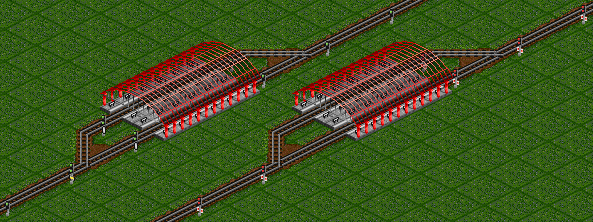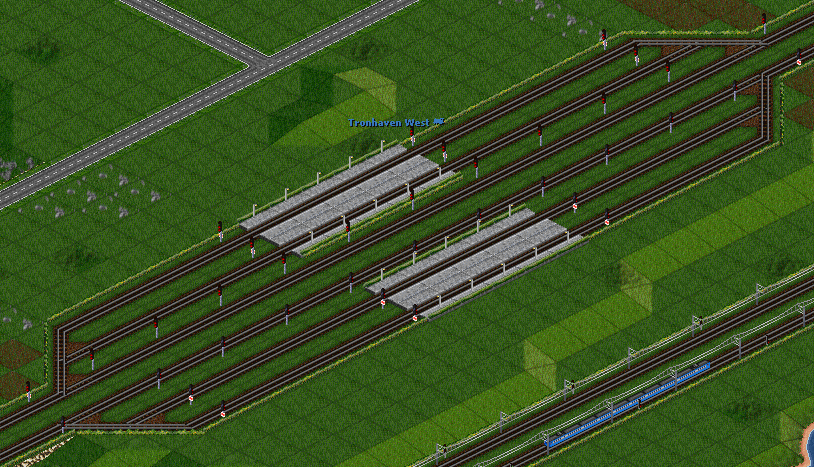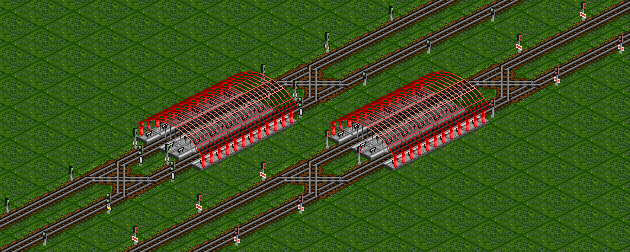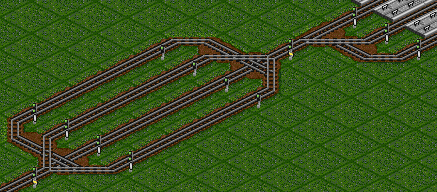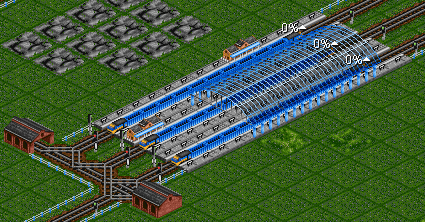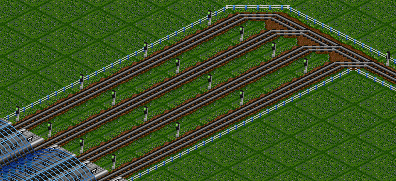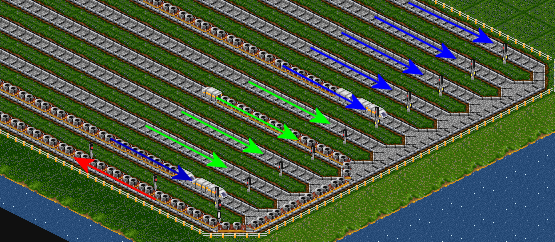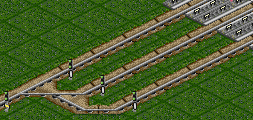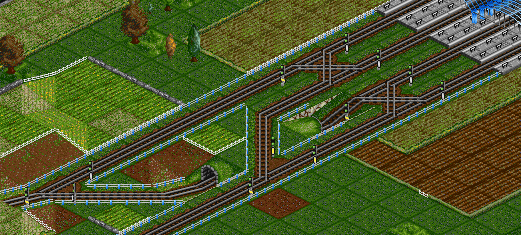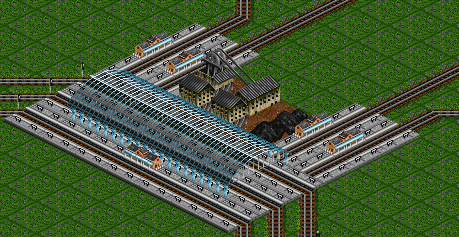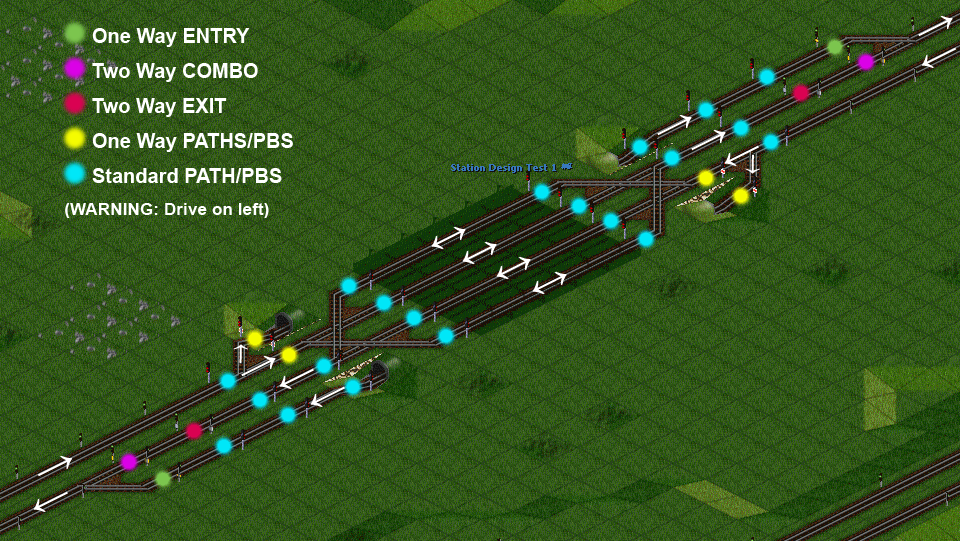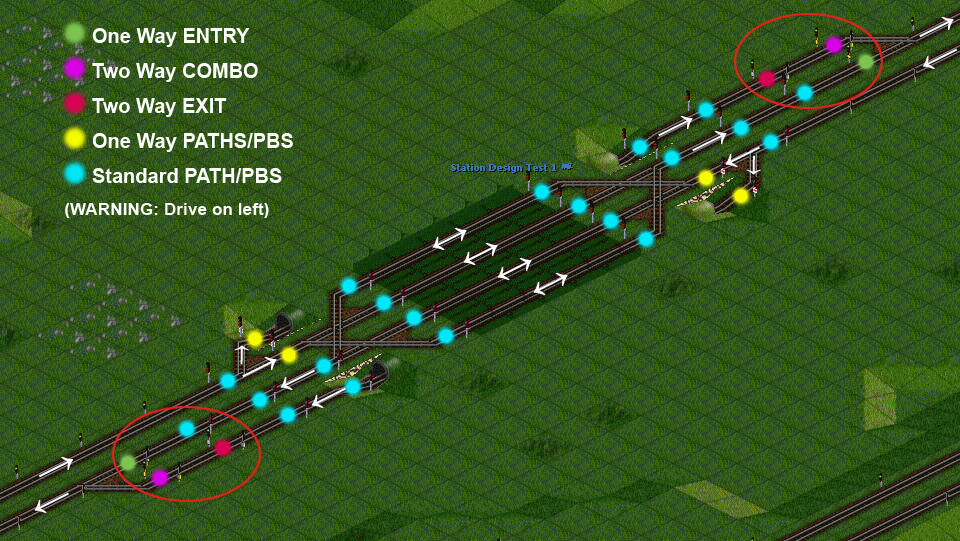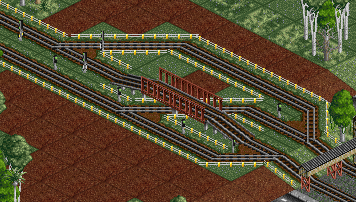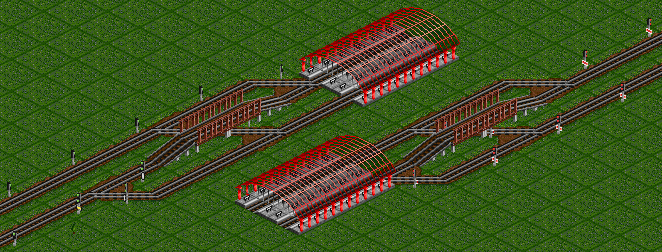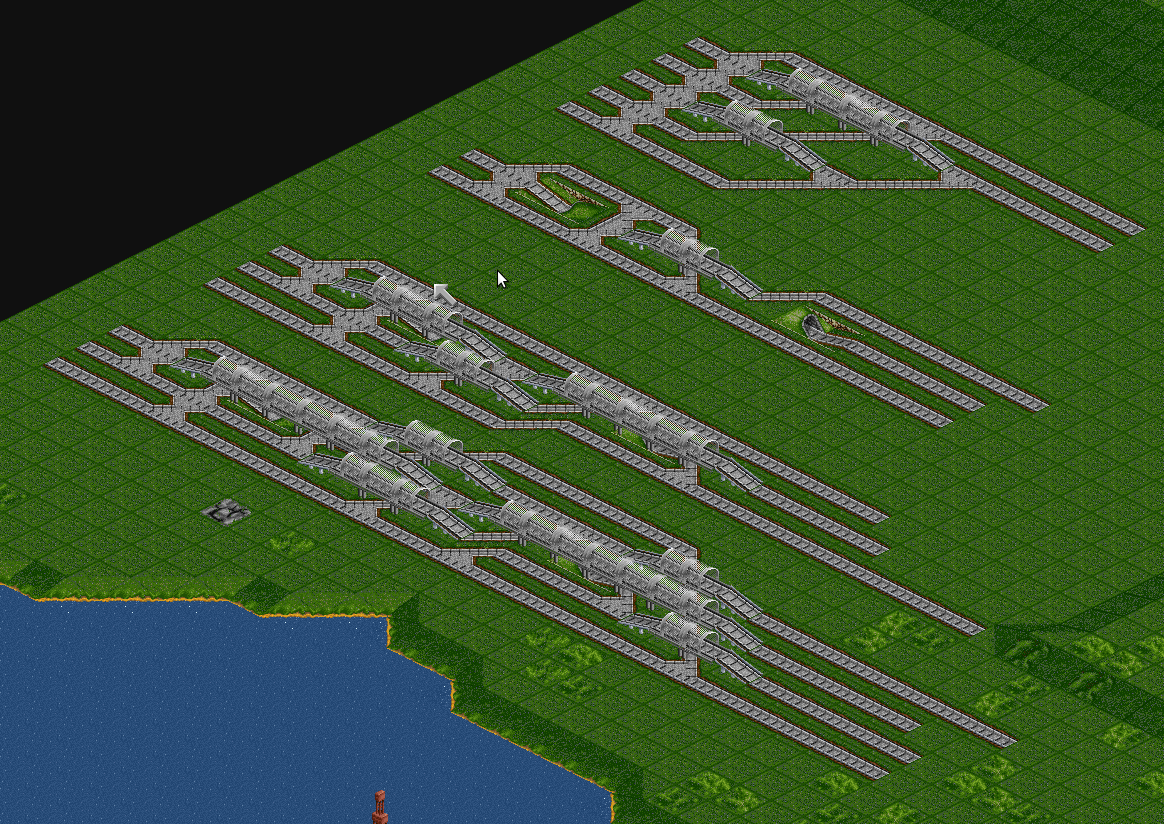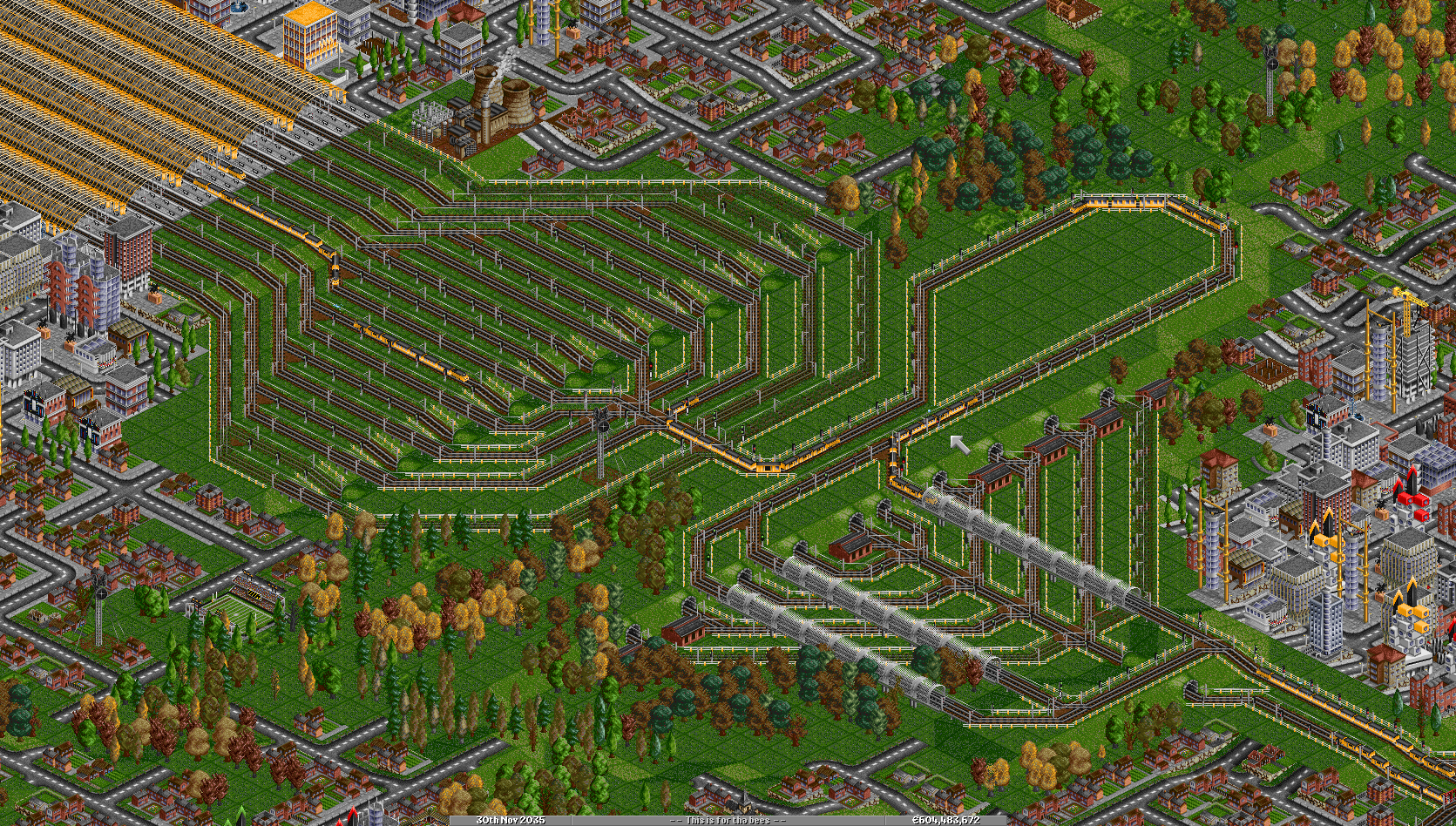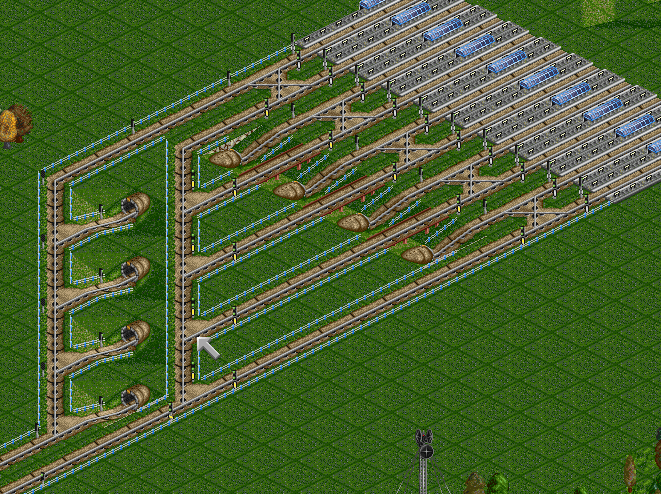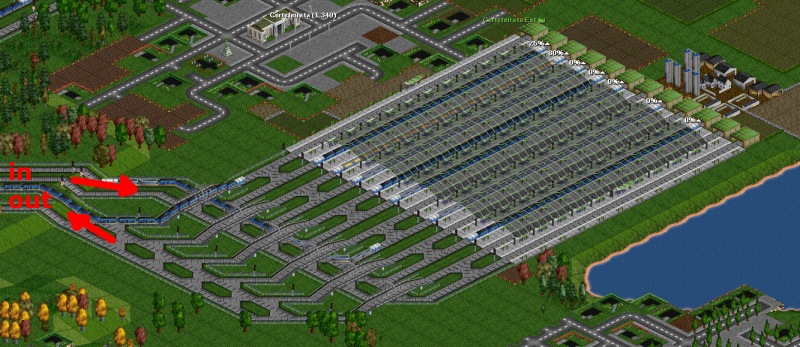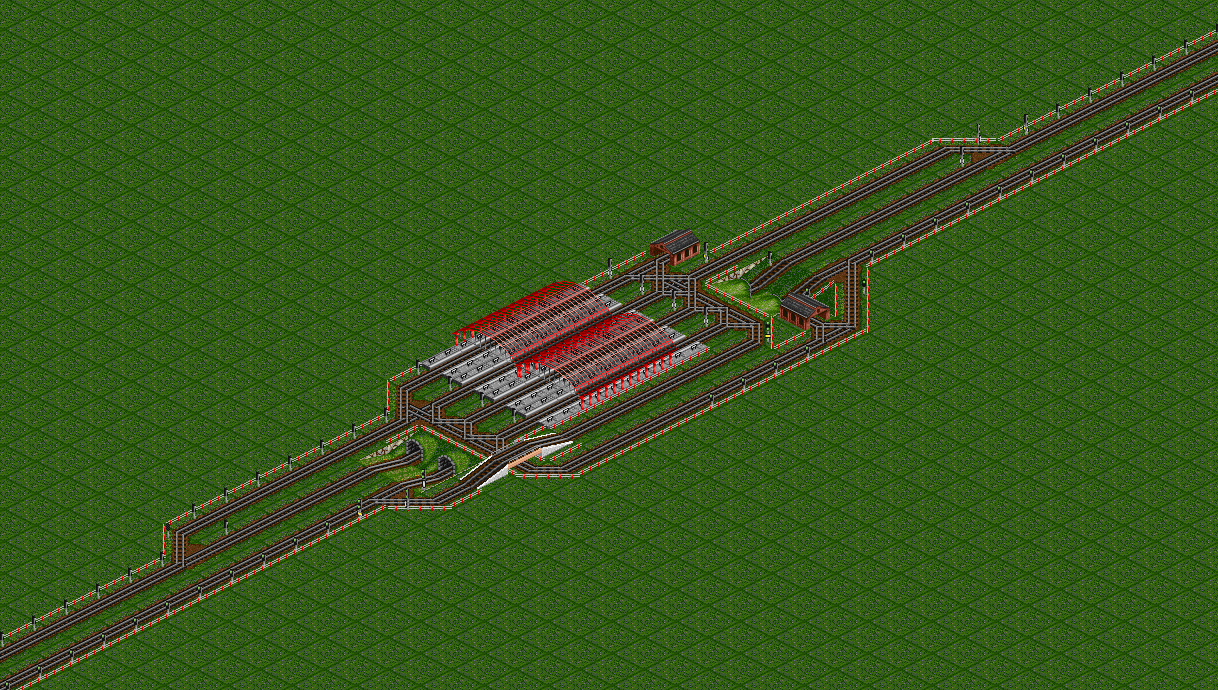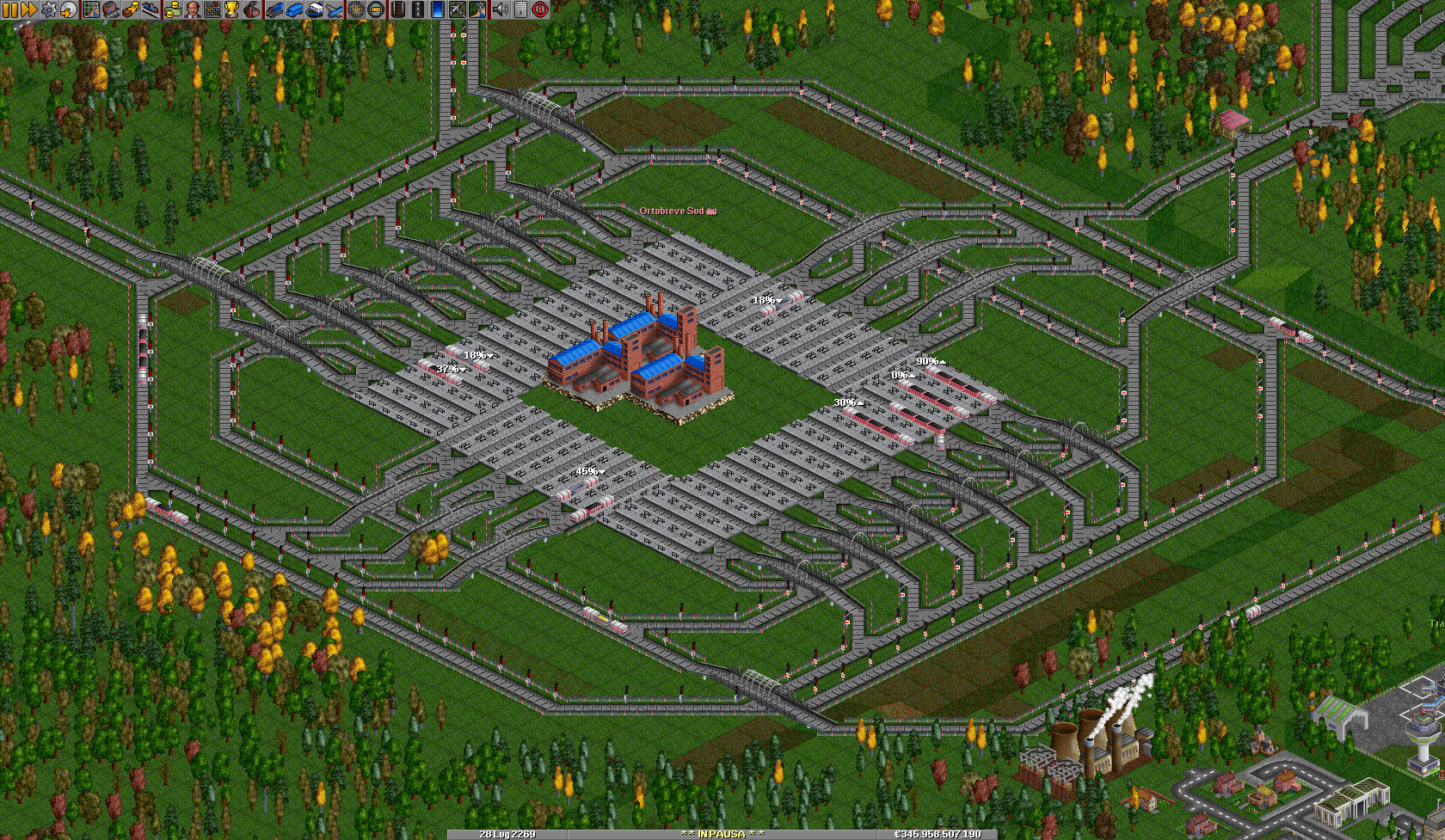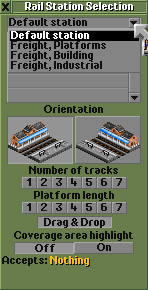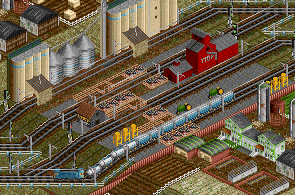Postępy: 50%
- Pomóż rozbudowywać poprzez pomoc w tłumaczeniu.
- Przeczytaj Instrukcję Stylów przed edycją.
- Pamiętaj, aby usunąć ten szablon, gdy artykuł zostanie przetłumaczony w całości.
- Sygnalizacja · Stacje · Skrzyżowania · Budowa składu · Projektowanie lini & Triki
Linie tramwajowe · Żegluga · Lotnictwo · Modyfikacja terenu
Zobacz też: Podstawowa wiedza z zakresu budowy stacji, Wszystkie rodzaje stacji Stacje kolejowe są podstawową częścią sieci kolejowych. Pozwalają na załadowanie różnych towarów do pociągu, oraz wyładowanie ich z niego. Dobrym pomysłem jest budowanie stacji poza główną siecią kolejową - pozwala to uniknąć niepotrzebnych przejazdów przez stacje, co normalnie mogłoby powodować opóźnienia pociągów.
Podstawowe stacje
Przedstawione poniżej stacje są proste w budowie i działają całkiem sprawnie, kiedy obsługują tylko kilka pociągów. Kiedy natężenie ruchu wzrośnie, możesz zechcieć sprawdzić konstrukcję zaawansowanej stacji
Stacja końcowa
Te stacje są końcem linii kolejowej. Pociągi opuszczają je w tym samym kierunku z którego wjeżdżały, więc mogą zablokować, pociąg wjeżdżający na stację bądź opuszczający ją (lub zostać zablokowane przez taki pociąg). Używane często jako proste i małe stacje lub kiedy nie ma wystarczająco miejsca na budowę stacji Ro-Ro.
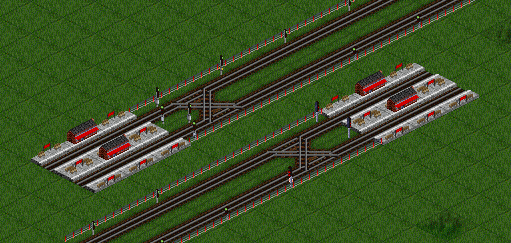
Prosta stacja końcowa: ta po lewej używa sygnalizatorów blokowych, prawa zaś sygnalizatorów trasy.
Stacja Ro-Ro
Ro-Ro jest skrótem od Roll-On, Roll-Off - pociągi wjeżdżają na nią z jednej strony i opuszczają z drugiej. Pociągi chcące wjechać na stację nie muszą czekać, aż inne z niej odjadą. Jest to dobre rozwiązanie dla średniego ruchu kolejowego. Nie jest to najlepsze rozwiązanie dla dużego zagęszczenia ruchu kolejowego (np. stacje obsługujące fabryki) bez instalowania pre-sygnałów , ponieważ kiedy wszystkie platformy są zajęte, pociągi mijają zwrotnicę i czekają na zwolnienie najbliższej platformy blokując tym samym zwrotnicę i nie pozwalając innym wjechać na drugą platformę, jeśli ta się zwolni.
Stacja
Podstawowa stacja, na której pociąg może się zatrzymać, lub przejechać obok. Zawiera obszary postojowe, na których pociąg oczekuje na dołączenie do głównej linii, lub zwolnienie platformy na stacji. Zauważ że obszar postojowy przed i za stacją mają długość przynajmniej równą z platformą stacji. Obszar postojowy przed stacją pozostawia miejsce na pociąg, by ten mógł poczekać na zwolnienie platformy bez blokowania linii głównej, a także pozwala mu wyhamować spokojnie poza nią, dzięki czemu nie spowalnia innych pociągów. Obszar za stacją pozwala pociągowi nabrać prędkości przed wjazdem na linię główną, oraz pozostawia miejsce, by ten mógł poczekać aż przejadą pociągi na linii głównej.
Połączenie stacji końcowej i Ro-Ro
Możliwym jest zbudować stację spełniającą dwie funkcje jak np. stacji końcowej i Ro-Ro. Są jednak trudności. W ustawieniach gry opcja „Train reversing” (zawracanie pociągu) musi być ustawiona na „At end of lines and stations” (na końcu linii i na stacjach) by mogła ona spełniać swoje zadanie. Pociągi będą w tedy mogły wjechać na stację z dowolnej strony i opuścić ją w dowolnym kierunku.
O ile konfiguracja z użyciem Path signals (sygnalizator ścieżki) będzie działać całkiem dobrze, o tyle użycie blok signals (sygnalizator bloku) spowoduje zablokowanie pociągu. Ma to miejsce, kiedy dwa pociągi nadjeżdżające z przeciwnych kierunków przekraczają entry-signal (sygnalizator wejściowy) praktycznie w tym samym momencie i chcą wjechać na tę samą platformę. Pierwszy pociąg wjedzie bez problemu, podczas gdy drugi zostanie zablokowany przed czerwonym exit-signal (sygnalizatorem wyjścia). Dla tego należy starać się nie używać blok-signal (sygnalizatorów bloku) lub korzystać ze stacji przy bardzo mały ruchu kolejowym.
Bag station
Jeśli z jakiś powodów nie masz miejsca na zbudowanie torowiska po obu stronach stacji, a stacja nie jest stacją końcową, Bag Station jest dobrym rozwiązaniem. Pociąg wjeżdża na stację, zawraca i wyjeżdża z niej kontynuując jazdę w swoim kierunku.
Stacja ta nie może być wybudowana na linii o dużym ruchu, ponieważ może na nią wjechać tylko jeden skład w każdym kierunku, zaś inne pociągi muszą poczekać, blokując główny tor. Można to rozwiązać poprzez budowę bocznicy, ale nie jest to rozwiązanie idealne. Pociąg musi zwolnić podczas wjazdu na nią, tak samo jak w przypadku w.w. stacji.
Zaawansowane Stacje
Dla sieci kolejowych o większym zagęszczeniu przedstawione wyżej stacje mogą okazać się niewystarczające do obsłużenia przypisanych do nich pociągów. Będziesz więc potrzebować bardziej zaawansowanych układów torów i sygnalizatorów.
Co się stanie gdy trzeci pociąg przyjedzie na którąś z powyższych stacji? Obydwa sygnalizatory są dla niego czerwone, więc wybiera najbliższy i czeka na zmianę świateł. Kiedy zwolni się druga platforma, trzeci pociąg w dalszym ciągu będzie czekał na zwolnienie pierwszej, przez co druga nadal pozostanie pusta a wjazd na nią najprawdopodobniej zablokowany przez oczekujący skład.
A co z kolejkami formującymi się za wjazdem na stację? Mogą one rozciągać się na duże odległości i doprowadzić do zaglokowania całej sieci kolejowej!
Pre-sygnały
Stacje z pre-sygnałami sprawiają, że nadjeżdżające pociągi czekają na zewnątrz stacji na zwolnienie platformy.
Poczekalnia
Dobrym rozwiązaniem aby przytrzymać kolejkę pociągów czekających na wjazd do stacji jest "poczekalnia". Jeżeli stacja jest zajęta nadjeżdżający pociąg wybiera najbliższą linię w "poczekalni". Jeżeli stacja jest już wolna jeden z czekających pociągów na nią wjedzie. Pamiętaj, że pociąg musi zmieścić się pomiędzy sygnałami. Pre-sygnały są opcjonalne, pomagają jeżeli twoja poczekalnia się zapełni.
Pętla
Alternatywą dla pre-sygnałów jest stworzenie pętli przed wjazdem na stację. Kiedy pociąg wjeżdża na stację i widzi że sygnały są czerwone (perony są zajęte) ,i jeżeli pętla nie jest zajęta przez inny pociąg, wjeżdża na pętle i robi okrążenie. jeździ tak długo aż pojawi się wolny peron. Minus tego rozwiązania jest taki że gdy pociąg porusza się po pętli inny pociąg w tym czasie może zająć wolny peron.
Pamiętaj jednak że pętla musi być wystarczająco duża by zmieścić twój najdłuższy skład kolejowy.
Escape depot
Another way of controlling station overflow is an "escape depot." Place a depot in the two-way/one-way signal set up at the entrance. Depots automatically have a (traditional) bi-directional signal in them so behave just like a loop around track. Escape depots, unlike loops, have an unlimited capacity.
The best layout has a depot at both ends of the station entrance. (This will reduce the time required to cross a large station)
Stacja z długim wyjazdem
Normalnie, kiedy dwa składy chcą opuścić stację w tym samym czasie,jeden musi swoje odczekać zajmując platformę stacji. Ciekawym rozwiązaniem jest wykonanie długiego wyjazdu. Pozwala on w szybki sposów zwolnić tor stację dla innych składów. jest to dobre rozwiązanie przy dość ruchliwej stacji.
Long exits, prioritized
Getting Mammoth trains (en) to exit a busy Ro-Ro station in a timely fashion can be challenging. By using pre-signals you can prioritize exit tracks to allow trains on faster tracks to depart sooner. In the image below a lower priority is assigned to the topmost 5 exits (since they'll block the return track longer) and the exit at the bottom (since trains accelarate slower on the sharp bend). This works because the low priority exits will wait for the exit signal to clear (that is, when a train passes the 2nd signal on the return track). The other tracks will depart when a train passes the 1st signal as usual.
Long entrances
If you play with Realistic acceleration (en), faster trains slow down a good bit before stopping in a station. This can delay the next train from entering. Adding a few track sections in front of the station can help with this.
Double entrance
This is a type of design used for stations that handle a huge number of trains, such as the stations servicing factories or food processing plants. Trains coming from one place can use loading bays meant for other trains if need be. Be sure to use pre-signals.
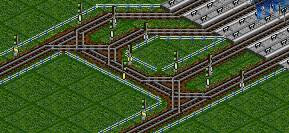
Double entrance. Those 4 platforms are divided into 2 groups with each handling 1 entry track. The combo-signal inbetween the junctions allows the trains from both entries entering the platforms simultaneously without interfering each other, but reserving the way for trains to cross-over to the other group when no platform is available on its group.
Feeder bays
If your rail network has large trains going long distances, it can be very cost effective to "feed" their loading station with more cargo from nearby industries. Because the longer distance the cargo travels, the more you get paid. In the pictured station, there are 4 bays for small trains to transfer coal from nearby mines. Large trains then deliver the coal to a far away power station.
Prioritised drive-thru stations
These stations are in the middle of a line and trains can pass them by without using up valuable platforms. Signalling makes a crucial difference here - you can give priority to the mainline trains or the stopping trains with them.
This station gives priority to trains leaving the station.
This station gives priority to trains passing the station by.
Ro-Ro Terminus
Principle
This style of station is a mix between the Ro-Ro and Terminus styles. In essence, it takes a terminus station and makes it possible for a train to leave its platform without disrupting the traffic flow entering the station. It can be used to upgrade a terminus style station and improve station efficiency. Modifications upon this design could increase the number of platforms to handle a larger number of trains at once. The example has been pre-signaled for greater efficiency.
This build allows trains to enter and exit station simultaneously. However, it takes a bit more space than ordinary terminus.
Variations
Giant Ro-Ro terminus
It's of course possible to increase the number of platforms of a Ro-Ro terminus station. You can go as far as you want as long as there's enough space.
Below is a little more efficient design, with two tracks each sharing an entry and exit line. It consumes half as much space while nearly not decreasing the capacity. It is important that the directions are not switched: Else trains would have to climb up when entering the track, blocking the crossing unneccessarily long.
Here bridges instead of tunnels
This station continues on that design, but with separate two pairs of separate entry/exit tracks.
| Mieszanka Ro-Ro Terminus o jeszcze większej wydajności |
This is a huge Ro-Ro terminus for very busy lines. There are 2 tracks inbound, 2 tracks outbound and 4 train can enter and exit at the same time (2 enter and 2 exit).
Advanced Combined Terminus- and Roro-Station
As with a standard ro-ro station, trains enter at one end of station and exit on the other end, thus trains entering the station do not have to wait for trains leaving. This station is designed so that non-stop trains can pass through the station without unnecessarily blocking empty platforms from trains that need to stop at the station. It can serve as a terminus station without the need to reverse train direction. It includes escape depots so it can endure heavy traffic even if there is no space to add additional platforms. This station design is an efficient trade-off between the fast advanced terminus types and saving precious building space.
Roundabout station
Can handle a huge amount of small trains.
NewGRF Stations
NewGRF (en) Stations, or newstations, are available after you have activated a Newstations grf file. You will then have access to a new station-building GUI.
The new GUI has a drop down box of station groups. Each group has a number of station tiles to choose from. Select a station tile and it will be previewed in the orientation boxes. Some newstation tiles do not allow trains to enter for the effect of full buildings or buffer stops. Be aware when placing newstation tiles that some tiles do not allow more than so many tracks or squares. The numbers not allowed will be greyed out and you cannot build this size. Some newstations sets offer more visual effects than others. For example, in Michael Blunck's newstations, passengers will gather on station platforms as the waiting cargo increases.
If the station set contains newgrf waypoints, the Waypoint GUI will open upon selecting it. You will have full previews of every waypoint possible for you to build. Most waypoints have introduction and obsoletion dates, in which waypoint styles will be replaced by newer versions. However, any waypoints you have already built will not automatically changed, allowing for variation on your networks.
Newstations behave the same as normal stations; the only difference is the non-track tiles that block trains.
















